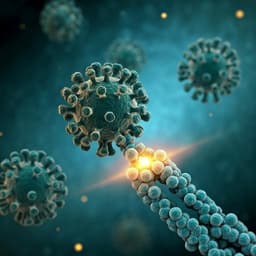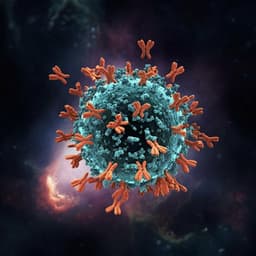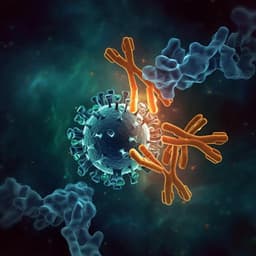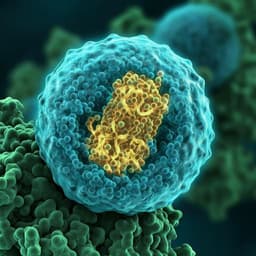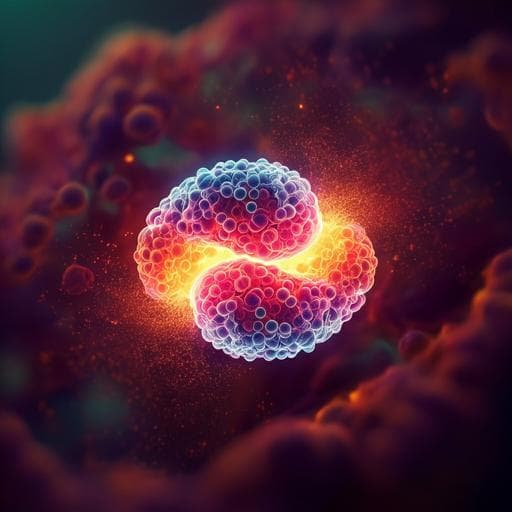
Medicine and Health
Hetero-bivalent nanobodies provide broad-spectrum protection against SARS-CoV-2 variants of concern including Omicron
H. Ma, X. Zhang, et al.
This groundbreaking study reveals two hetero-bivalent nanobodies that effectively neutralize various SARS-CoV-2 variants, including Omicron. Researchers, including Huan Ma, Xinghai Zhang, and Peiyi Zheng, highlight the potential of aRBD-2-5-Fc for COVID-19 prevention and treatment, demonstrating significant protection in hamsters.
~3 min • Beginner • English
Introduction
The SARS-CoV-2 pandemic continues to threaten global health and economy. The adaptive evolution and spread of variants of concern (VOCs) have reduced the efficacy of vaccines, notably with Omicron carrying over 30 spike mutations leading to breakthrough infections even in fully vaccinated populations. Challenges include insufficient vaccine response in immunocompromised individuals and inequitable access. Passive immunization with RBD-targeting neutralizing antibodies is promising, but many authorized antibodies show loss or reduction of activity against VOCs, particularly Omicron. Nanobodies (VHHs) offer advantages over conventional antibodies and many RBD-directed Nbs have been isolated; however, these too face variant escape, especially from Omicron. The study aims to define structural mechanisms and evaluate breadth and potency of hetero-bivalent Nbs (aRBD-2-5 and aRBD-2-7) against major SARS-CoV-2 variants, including Omicron, and assess their in vitro and in vivo protective efficacy.
Literature Review
Methodology
- Structural determination: Crystal structures were solved for RBD:aRBD-5 (monomeric WT RBD with aRBD-5) at 1.8 Å and RBD-tr2:aRBD-2-7 (tandem repeat RBD dimer with aRBD-2-7) at 3.2 Å. Complexes were formed at ~1:1.2 molar ratio, purified by gel filtration, crystallized via sitting-drop vapor diffusion, and data collected at SSRF beamlines. Phasing used molecular replacement (Phaser) with known models; model building and refinement used COOT and Phenix. Structures deposited as PDB 7VOA (RBD:aRBD-5) and 7FH0 (RBD-tr2:aRBD-2-7). Superposition analyses aligned Nb-RBD complexes onto cryo-EM spike structures in different RBD up/down conformations and compared with other Nb/antibody epitopes.
- Protein engineering/production: Coding sequences for variant RBDs (WT and Alpha, Beta, Gamma, Delta, Delta plus, Kappa, Lambda; Omicron BA.1/BA.2 purchased) were cloned with C-terminal TEV site and human IgG1 Fc, expressed in HEK293F, purified via Protein A and protease processing. Nbs and Fc-fused constructs produced similarly: aRBD-2, aRBD-5, aRBD-7, hetero-bivalents aRBD-2-5 and aRBD-2-7 (3xGGGGS linker), Fc-fused versions, and control fusion aRBD-2-amL1-Fc.
- Conservation analysis: GISAID EpiCoV spike sequences (5,971,331 high-quality entries; Sept 1, 2021–Feb 28, 2022) were analyzed to compute conservation of RBD residues contacting aRBD-2 versus controls (E484, N501), using BLAST alignments and custom scripts.
- Binding assays: Surface Plasmon Resonance (Biacore T200) for K_D values: Nb-Fc immobilized on CM5 (pH 4.5) and variant RBDs injected; 1:1 binding model fits. ELISA measured EC50 binding for constructs intolerant of SPR regeneration (aRBD-7-Fc, aRBD-2-7-Fc) against RBD variants.
- Virus neutralization: Authentic virus assays: plaque reduction neutralization test (PRNT) on Vero E6 against WT, Beta, Delta, Omicron BA.1 (75 PFU), and micro-neutralization counting infected cells for Alpha, Gamma, Kappa (200 PFU). Pseudovirus neutralization: HIV-1-based luciferase pseudoviruses for Omicron BA.1, BA.1.1, BA.2 on ACE2-293T cells; IC50s calculated from dose-response.
- Animal studies: Prophylaxis in K18-hACE2 mice: single i.p. 10 mg/kg aRBD-2-5-Fc 24 h before i.n. challenge with 2×10^4 PFU WT; monitor weight and survival 7 days. Prophylaxis in BALB/c mice with MA10 (mouse-adapted) challenge: single i.p. 1 or 0.1 mg/kg 24 h before intratracheal 1×10^5 PFU; weight monitored. Hamster Omicron BA.1 study: 10 mg/kg i.p. 24 h before (prophylactic) or 3 h after (therapeutic) i.n. 1×10^4 PFU; at 4 dpi measure viral RNA (qRT-PCR) and infectious titers (plaque assay) in trachea and lungs; body weight tracked.
- Pharmacokinetics: Single 10 mg/kg i.p. dose in mice (C57BL/6) and hamsters; serial plasma sampling; ELISA quantification against RBD to derive concentrations; two-compartment model half-life estimation.
- Statistics: GraphPad Prism 9, unpaired t-test with Welch’s correction; p ≤ 0.05 considered significant.
Key Findings
- Structural epitope mapping: aRBD-2 binds a conserved RBM epitope near the ACE2 site, burying 639.1 Å^2 and contacting RBD residues D420, Y421, F456, R457, N460, Y473, Q474, A475, N487, Y489. aRBD-5 and aRBD-7 bind overlapping epitopes on the RBM concave surface (buried areas 697.9 and 669.3 Å^2, respectively) partially overlapping ACE2. aRBD-2 does not clash with aRBD-5 or aRBD-7; aRBD-5 and aRBD-7 compete.
- Binding mode on spike: All three Nbs can bind “up” RBDs; aRBD-5/7 can also bind “down” RBDs; aRBD-2 cannot bind “down” due to steric clashes. Hetero-bivalent design with 3×GGGGS linker allows simultaneous binding for aRBD-2-5 (same or adjacent up RBDs). aRBD-2-7 can bind simultaneously only when aRBD-2 engages an “up” RBD and aRBD-7 a neighboring “down” RBD.
- Epitope conservation: GISAID analysis shows aRBD-2-contact residues are highly conserved (99.966–99.999%); controls E484 and N501 show ~63% conservation. Contact residues remain conserved across all major VOCs/VOIs/VUMs up to May 31, 2022.
- Binding affinities (SPR/ELISA): aRBD-2-Fc binds WT and variant RBDs with K_D 1.20–7.96 nM; reduced affinity for Beta/Gamma/Delta+ likely due to K417 mutations; BA.1/BA.2 about 5-fold weaker (S477N and K417N effects). aRBD-5-Fc binds WT/Alpha/Delta/Delta+ (K_D 1.90–3.21 nM) but loses binding to Beta, Gamma, Kappa, Lambda, BA.1, BA.2. aRBD-2-5-Fc shows synergistically enhanced affinity: K_D 0.0168–<0.001 nM for WT/Alpha/Delta/Delta+; retains sub-nanomolar affinity for variants that escape aRBD-5 (e.g., Beta 0.714 nM; Gamma 0.668 nM; Kappa 0.808 nM; Lambda 0.053 nM; BA.1 0.171 nM; BA.2 0.0591 nM). ELISA shows aRBD-2-7-Fc improved binding to multiple variant RBDs versus aRBD-2-Fc; aRBD-7-Fc loses binding to Beta, Gamma, Kappa, Lambda, BA.1, BA.2 and is weak to Delta/Delta+.
- Neutralization (authentic and pseudovirus): Against authentic WT and Delta, aRBD-2-5-Fc IC50 0.0830 nM and 0.0271 nM; aRBD-2-7-Fc 0.0389 nM and 0.0534 nM; comparator Nb21-Fc: 0.0557 nM (WT), 0.0305 nM (Delta). Against authentic Beta: aRBD-2-5-Fc 0.0438 nM; aRBD-2-7-Fc 0.1031 nM; Nb21-Fc failed. Against authentic Omicron BA.1: aRBD-2-5-Fc 0.0293 nM; aRBD-2-7-Fc 0.1299 nM; Sotrovimab 2.5710 nM. Pseudoviruses BA.1/BA.1.1/BA.2: aRBD-2-5-Fc IC50 0.0202/0.0127/0.0311 nM; aRBD-2-7-Fc 0.0319/0.0498/0.0768 nM; Sotrovimab 0.6616/1.3240/4.796 nM; Nb21-Fc no neutralization. Thus, aRBD-2-5-Fc outperforms Sotrovimab by 33–154 fold on Omicron pseudoviruses.
- In vivo efficacy: K18-hACE2 mice prophylaxis (10 mg/kg, 24 h before WT challenge 2×10^4 PFU): PBS controls had ~20% weight loss by day 5 and 100% mortality by day 7; aRBD-2-5-Fc group had no significant weight loss and 100% survival. BALB/c mice MA10 prophylaxis (1 or 0.1 mg/kg): PBS controls had max 13.0% weight loss at 2–3 dpi; 0.1 mg/kg group showed transient weight loss (max 13.9% at 2 dpi); 1 mg/kg group minimal loss (max 2.2% at 2 dpi); all survived.
- Hamster Omicron BA.1 study (10 mg/kg): At 4 dpi, prophylactic group showed reductions in viral RNA by 10^1.73 (trachea), 10^3.41 (left lung), 10^3.13 (right lung) versus controls; therapeutic group reductions of 10^0.75, 10^2.84, 10^2.09, respectively. Infectious virus was undetectable in both treated groups, while controls had mean titers ~10^2.08–10^3.40 PFU/g in tissues.
- Pharmacokinetics: aRBD-2-5-Fc displayed linear PK with estimated half-life of ~165 h in mice and ~72 h in hamsters; well tolerated with no significant weight loss.
Discussion
The study addresses the need for broad-spectrum countermeasures against evolving SARS-CoV-2 variants by targeting conserved epitopes and engineering multivalent nanobody constructs. Structural analysis shows aRBD-2 recognizes a highly conserved RBM epitope constrained by functional requirements for ACE2 interaction and RBD stability, explaining its preserved binding across VOCs including Omicron sublineages. Although aRBD-5 and aRBD-7 alone lose binding to several variants due to mutations at key residues (e.g., E484, Q493, L452, F490), their fusion with aRBD-2 dramatically enhances overall avidity and ACE2-competition, maintaining potent neutralization breadth. Hetero-bivalency thus confers resilience to mutational escape compared to antibody cocktails where both components may be escaped simultaneously. The nanobody-based multivalent approach also offers manufacturing and stability advantages. In vitro neutralization demonstrates low-picomolar potency across WT, Beta, Delta, and Omicron BA.1/BA.1.1/BA.2, surpassing Sotrovimab and comparable to leading monoclonals like LY-CoV1404 in some settings. In vivo, aRBD-2-5-Fc provided robust prophylactic protection in lethal and non-lethal mouse models and eliminated infectious Omicron BA.1 in hamster lungs under both prophylactic and therapeutic regimens. These results underscore the significance of conserved-epitope targeting combined with multivalency to achieve breadth and potency against current and emerging SARS-CoV-2 variants.
Conclusion
This work defines the structural basis and demonstrates the broad-spectrum efficacy of hetero-bivalent nanobodies against SARS-CoV-2 variants, including Omicron sublineages. aRBD-2 targets a uniquely conserved RBM epitope and, when fused to aRBD-5 or aRBD-7, yields multivalent constructs (aRBD-2-5-Fc, aRBD-2-7-Fc) with synergistically enhanced affinity and potent neutralization across major VOCs. aRBD-2-5-Fc confers strong prophylactic and therapeutic protection in animal models and exhibits favorable pharmacokinetics, highlighting its translational potential for COVID-19 prevention and treatment. Future directions include elucidating structural mechanisms of aRBD-2-5 binding to variant RBDs, optimizing dosing regimens, evaluating additional administration routes such as inhalation, and expanding nanobody combinations to fortify breadth against ongoing viral evolution.
Limitations
- Structural mechanism of how aRBD-5 contributes to overall affinity in the aRBD-2-5 fusion against variants it does not bind alone was inferred; definitive structures of aRBD-2-5 bound to variant RBDs are needed.
- Hamster Omicron BA.1 antiviral assessment measured viral loads at 4 dpi when control titers were relatively low; earlier time points may better capture peak replication.
- Only a single 10 mg/kg dose was evaluated for prophylactic and therapeutic efficacy against Omicron BA.1 in hamsters; dose–response and optimal regimens remain to be determined.
Related Publications
Explore these studies to deepen your understanding of the subject.



